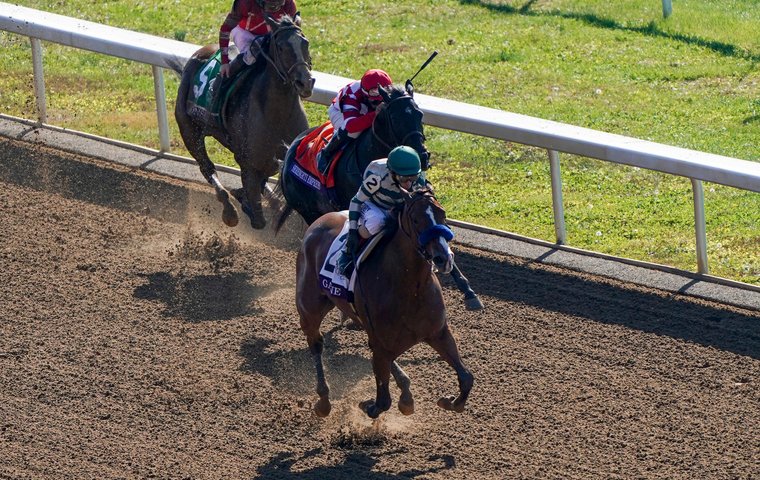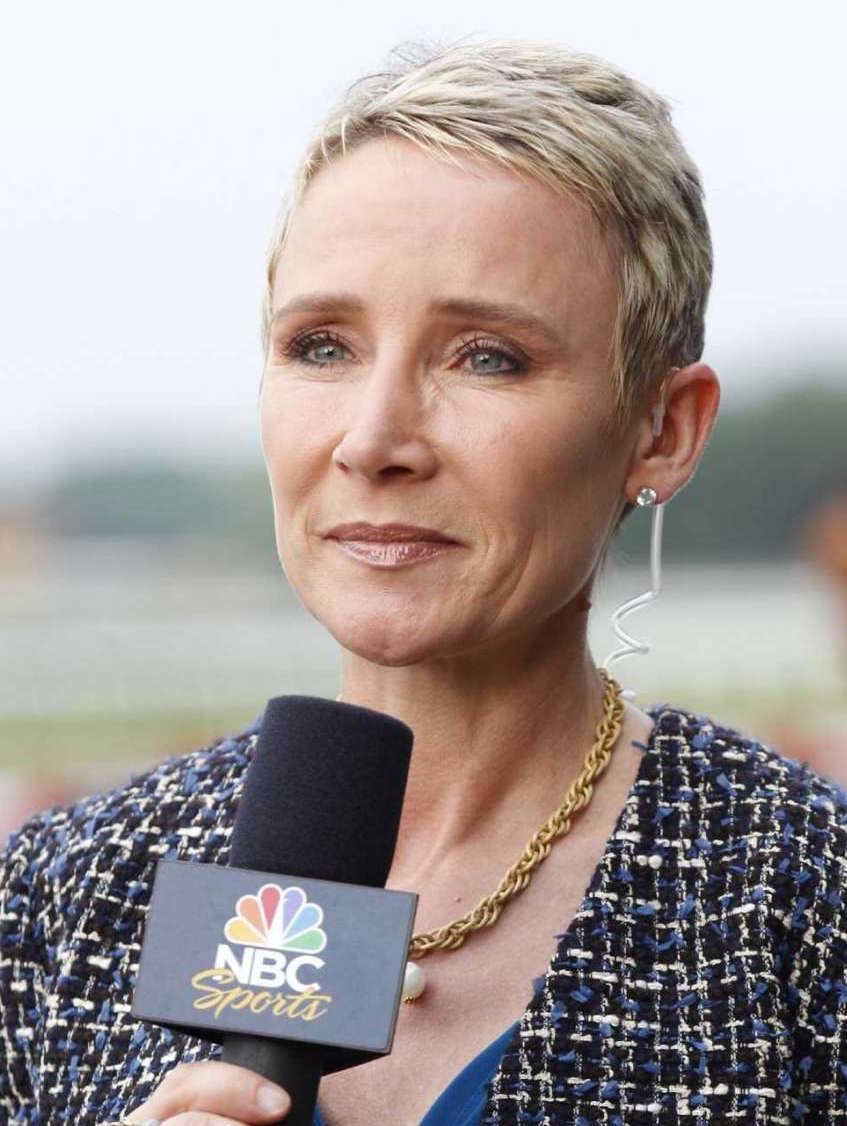
“I really, honestly think that there are maybe 500 things going through your mind all at one time at the start of a race.”
 There is multi-tasking and then there is riding a racehorse. The quote above is from Donna Barton-Brothers (pictured), former American jockey and mounted racing reporter for NBC Sports TV. Her job is to interview winning riders after major races for the network at the Triple Crown and Breeders’ Cup races.
There is multi-tasking and then there is riding a racehorse. The quote above is from Donna Barton-Brothers (pictured), former American jockey and mounted racing reporter for NBC Sports TV. Her job is to interview winning riders after major races for the network at the Triple Crown and Breeders’ Cup races.
It is telling that those “500 things” are only about the start of a race - the first three jumps or strides. There is a whole race to be run with multitudinous and mind-boggling factors. We are, firstly, talking about often fractious and unpredictable 1,100 to 1,200lb animals. We’re also talking about riding perched on a mount, precariously balanced not on the horse, per se, but on top of the horse.
Additionally, jockeying a horse bears no resemblance to even the fastest gallop across a paddock or field. A jockey is holding reins and a riding crop, piloting a big animal in extremely close quarters — traffic, if you will — at speeds that can exceed 40 miles per hour.
Interesting, too, about the start, is it’s probably the only stage of a race where a jockey has the least impact or influence. “With the first three or four strides, you just have to let your horse ‘begin’,” said Umberto Rispoli, Italian jockey and veteran of European racetracks and most recently Hong Kong before moving his tack to Southern California in 2019. He captures, in accented English, maybe the perfect word to capture what the start is all about.
Rispoli added something that reinforced the minimal role of a jockey at a race’s start. “Most of the time [with a bad break from the gate] they’ll say the jockey missed the start. The jockey never missed the start, the horse did,” he said without equivocation.
The task after the first three strides is where there is separation between good riders and bad, said Barton-Brothers. She cites the 2020 Breeders’ Cup Filly & Mare Sprint at Keeneland as an exquisite example of early-position strategy and well, brainpower, to win a race early on.
The sprint was, as it turned out, a 2-horse race — between Serengeti Empress and Gamine — both of whom preferred early leads. In fact, according to Barton-Brothers, anything short of being on the lead virtually guaranteed defeat for trainer Tom Amoss’s Serengeti Empress. “He’s taken riders off because they tried to go to Plan B,” she said. “You get to the lead or she doesn’t win.”
Velazquez’s ‘Hall of Fame ride’
Jockey Luis Saez on Serengeti Empress, naturally, gunned his horse out of the gate from the seventh post and to the inside to be ahead of Gamine breaking from the No.2 gate. Interviewing Gamine’s jockey, Johnny Velazquez, after the race, the Puerto Rican Hall of Famer told Barton-Brothers he had a strategy for the race proving him to be not only a good but great rider.
Velazquez knew Serengeti Empress was going to go for the lead and his plan was to make her go extremely fast with an all-out effort to get it.
This is exactly what happened with a first quarter run in 21:77 seconds (see video above). The plan, actually, was 3-fold:
- To exert Serengeti Empress to a blistering pace
- To distance both his horse and Serengeti Empress from the rest of the field
- To take Gamine back just behind Serengeti Empress to give his filly “a bit of a breather”. The breather would conserve Gamine’s energy and enable her to “pounce” on Serengeti Empress late, as Velazquez described it.
“He’s in the Hall of Fame for a reason, and that was a Hall of Fame ride,” said Barton-Brothers.
The Sprint was a classic example of what jockeys call race-riding, doing something that was observed about the great retired jockey Angel Cordero: He didn’t just ride his horse but his competitors, too.
Pat Day’s intuition
While Velazquez had a carefully scripted plan, other riders are strictly intuitive.
After the start and early position, Hall of Fame jockey Pat Day’s strategy in the first turn was simply to “let them get comfortable”. Day was also mindful, even this early in a race, of not “draining the tank”.
“I’m a firm believer that the best horse in the world has about, at the outside, a quarter-of-a-mile sprint, an all-out quarter-mile ‘punch’,” he said. “You can use that from the half-mile pole to the quarter pole and hope you’ve gained enough distance on the field to stagger to the wire in front. Or you can conserve that and use it when you feel it’s necessary.”
Out of the first turn and on the backstretch, it’s a matter of maintaining position, or, if necessary, improving position without using too much of the horse’s energy.
Barton-Brothers remembered how Cash Asmussen, 5-time champion jockey in France, used to drive his brother, trainer Steve, into apoplexy when he rode in the U.S. with an experiment, of sorts, on the backstretch. “Cash sometimes liked to see how much horse he had coming down the back stretch, and he would ask for them and then slow them down again. That would drive Steve crazy.
“You just have to trust your horse. What’s the point of asking them at the half-mile pole just to make sure you ‘have horse’? If you don’t have horse, it’s not going to help you any more later,” she laughed.
The far turn in a 2-turn race is where, of course, the stretch run actually begins to take shape. One of U.S. riding great Pat Day’s most perplexing experiences that stands out among his 40,000-plus races was on a horse named Menifee in the 1999 Blue Grass Stakes, a prep for the Kentucky Derby.
“Riding Menifee that day, he was in the bridle. He was there. He was giving me every indication that, as soon as I gave him a squeeze, he would accelerate.” Going into the turn at Keeneland’s half-mile pole, Day changed holds on the reins, smooched at the horse … and got nothing.
“Why I felt comfortable at that point to not encourage him, or squeeze him or force him to get back into the race, I don’t know. I was completely comfortable to let him drop back. So now, Jerry Bailey, who had been right behind me, when he saw me do that, figured, ‘Okay, he’s out of horse.’ So he pulled out and went on past me and now, instead of being third, I’m fourth, and I believe at that point another horse passed me.
“So now, we’re in the middle of the turn and I just angled him toward the fence, saved some ground, again, completely comfortable to let him lollygag around.
“As we got down close to the fence, he started to get back into the bridle. We cut the corner, came to the inside, ran up behind the horses that had been leading, eased out from behind them, came down the stretch, and won (see video below).
“When I get back to the jockey’s quarters, Jerry came up to me, shook his head and said quizzically, ‘I thought you were out of horse.’ I shrugged and said, ‘I thought I was, too.’ Why I was completely comfortable to let him drop back God only knows.”
Less intuitive riders employ a rule of thumb in the far turn, surprising in something as naturally evolving as a horse race: If running behind a 3-horse wall in front of your mount, you wait on a hole to open; if it’s only 2 horses and you have the horse beneath you, to do it you go around.
Rispoli weighs another factor into the equation if following horses in the far turn: Knowing who is on those horses in front of you. “With a Hall of Fame jockey like John Velazquez, you know that he is on a live horse.” Separating from horses running alongside is likely to happen with a Velazquez mount, opening up space that can be filled by his horse down the stretch.
Accounting, perhaps, for success in America (he is currently world-ranked 56 in the TRC standings), Rispoli likes to stay on the rail rather than circle other horses from outside and often sees the rail open as horses enter the home stretch.
The run to the wire is not the frantic, mad dash imagined by the casual racing fan. ‘Throwing crosses’ down the stretch, or tightening the reins to increase pressure on the bit in the horse’s mouth to ask for more exertion, and use of the crop can cost a jockey a race. According to Rispoli, that might signal the horse to switch leads, which could be going back to the tired leg they just led with in the turn.
“You have to be smooth,” he said.
Crop use
Crop use for Rispoli is something he typically reserves for the last six or seven strides to get a final effort to beat another horse to the wire. Switching hands can be critical also.
The 2020 Del Mar Derby bore this out for Rispoli. “I couldn’t get at the leader. I switched the crop from the left to the right and I got the horse on the wire.”
It is obvious that great race-riding is a combination of more than just horse, but position, intuition, patience, strategy and maybe 496 other things.
Summing up maybe what is most important, Barton-Brothers recalled something her mother, also a jockey, once said, “I won more races with my brain than I ever did with my muscles.”
This article was first published in Gallop magazine


